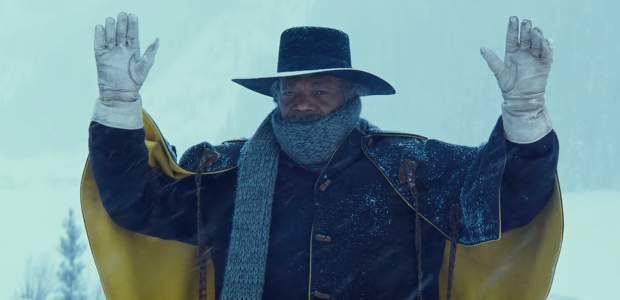Molasses is a word used more than once in The Hateful Eight, Quentin Tarantino’s cleverly titled eighth film. When you first hear the word spoken you don’t think much of it. It’s when you hear it again that you start to draw on its literal and figurative meaning. Chronologically, this is his ninth film (Tarantino considers Kill Bill: Vol. 1 & Vol. 2 as one film) but the one common aspect in all his films is the known fact that as the writer and director, Tarantino is in no rush to tell his story. Just as viscid as molasses is the narrative, but also as concentrated, making this one of his most verbose, bloody and thoroughly unpredictable films. And binding everything together is an even more concentrated dose of tongue-in-cheek humour that is an absolute treat for every Tarantino fan.
It takes “patience” to get there though, another word used overtly to tell the audience that the reward is worth the wait. Told as a post-Civil War era western in whiteout Wyoming, The Hateful Eight is essentially a tightly wound potboiler seamlessly knitted into a whodunit murder mystery. And although the story seems like a Tarantino original, the plot summary appears to have germinated from the same nucleus that made And Then There Were None Agatha Christie’s magnum opus. The similarities are there, yet somehow Tarantino’s masterstrokes feel intimately traditional, like a nuanced director returning to his roots.
That tradition is felt almost entirely through the film, beginning with his signature approach to compartmentalising the narrative into chapters. Crossing over one-third the length of the film, Chapters one, two and three serve as the introduction to eight characters so eclectic that the film could have also been titled ‘The Fateful Eight’. Leading the pack are bounty hunters Major Warren (Samuel L. Jackson) a former Union army soldier, and John Ruth (Kurt Russell) on the way to the town of Red Rock to hang his prisoner Daisy Domergue (Jennifer Jason Leigh) for a bounty of $10,000. After picking up a fourth passenger, Red Rock’s newly appointed Sheriff Mannix (Walton Goggins), their stagecoach stops for the night at a desolate cabin called Minnie’s Haberdashery. Here’s where they (and we) meet the remaining four – Red Rock’s Hangman Oswaldo Mobray (Tim Roth), retired Confederate army General Sandy Smithers (Bruce Dern), Joe Gage (Michael Madsen) a cowboy working on his autobiography, and Bob the Mexican, the cabin’s caretaker. Trapped by a terrible blizzard on the outside and confined to suspicious strangers on the inside, tensions rise when most are not who they claim to be. Thus begins Chapters four, five and six, and traditionally where Tarantino lets the proverbial ‘shit hit the fan’.
Before that happens, suspense driven buildup takes precedence by way of character driven performances and spitfire dialogue from everyone including whimsy cameo appearances. With Jackson in the lead and at his profane best, the remaining ensemble offer concrete support, each equipped with electrifying delivery and nestled surprises. But none more than the film’s most concealed character – with a constant smirk on her face, Leigh’s Daisy is perhaps Tarantino’s biggest Easter egg with an unpredictable outcome. Equally delectable is the heavy dosage of dark humour, both witty and outrageous, and at an all-time high for a Tarantino film. So is the racial slur, which peaks in the form of an epic sexual gag between Warren and the N-bombing Smithers.
While Django Unchained proved to be homage to the 60s era of Sergio Leone westerns, The Hateful Eight feels more like Tarantino’s first real thriller. Shot in 70mm Panavision with the legendary Ennio Morricone (who invented the Spaghetti Western genre with Leone) providing a tense and menacing soundtrack, this could not only prove to revive the western but also Tarantino outdoing his own brand of wickedly entertaining audacity. And lauded more for his screenwriting than his diabolical exploitation, this is probably his fastest film to get through even though it’s over three hours long with a plot that thickens with each passing minute. Perhaps even thicker than molasses.
Rating: 




